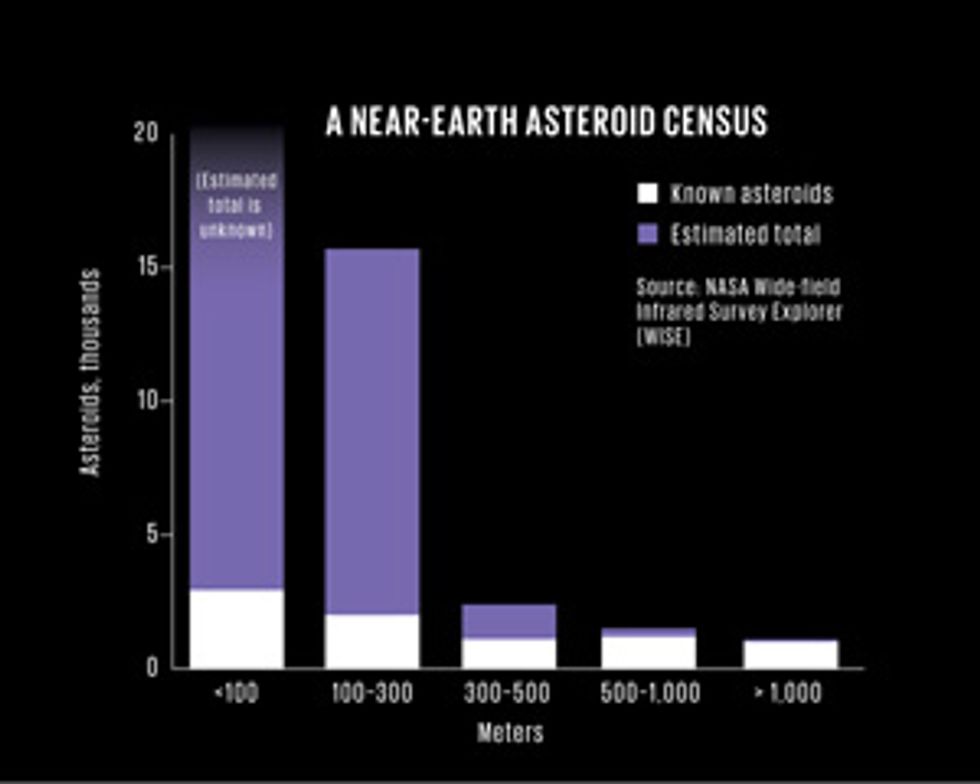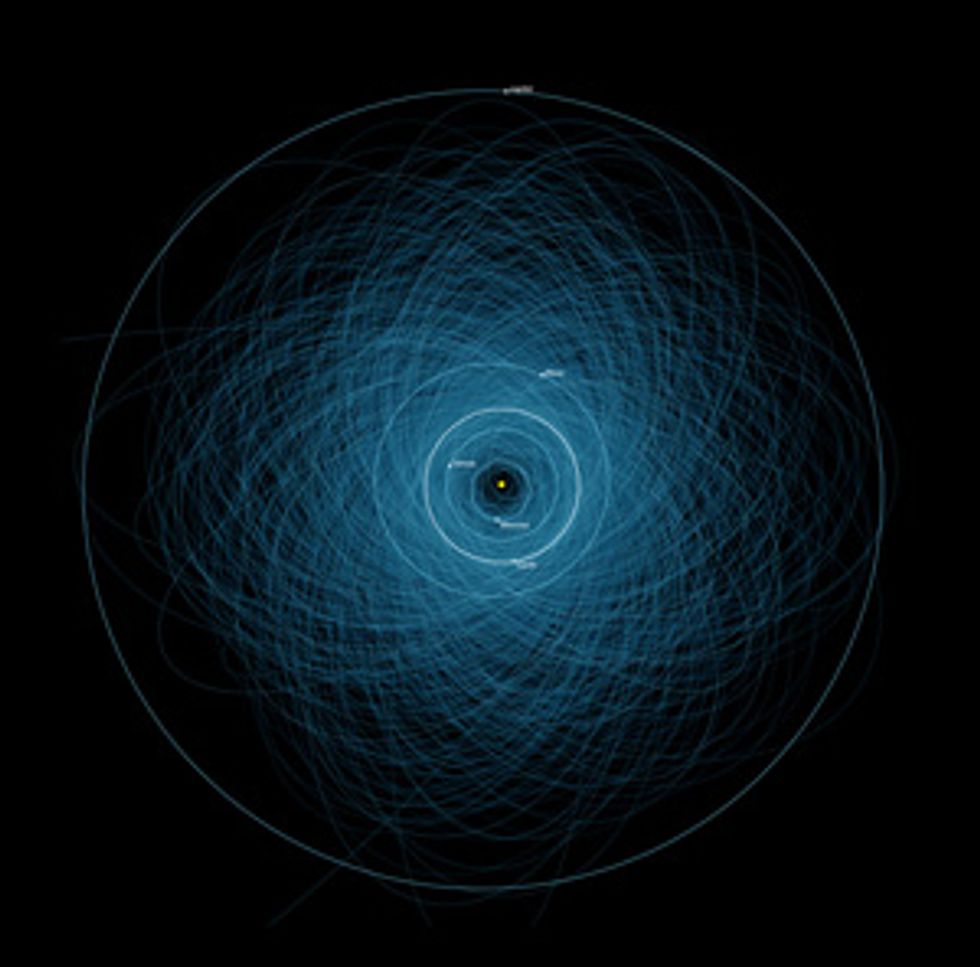Sentinel’s Mission to Find 500,000 Near-Earth Asteroids
The privately funded space telescope will hunt for objects on a collision course with Earth
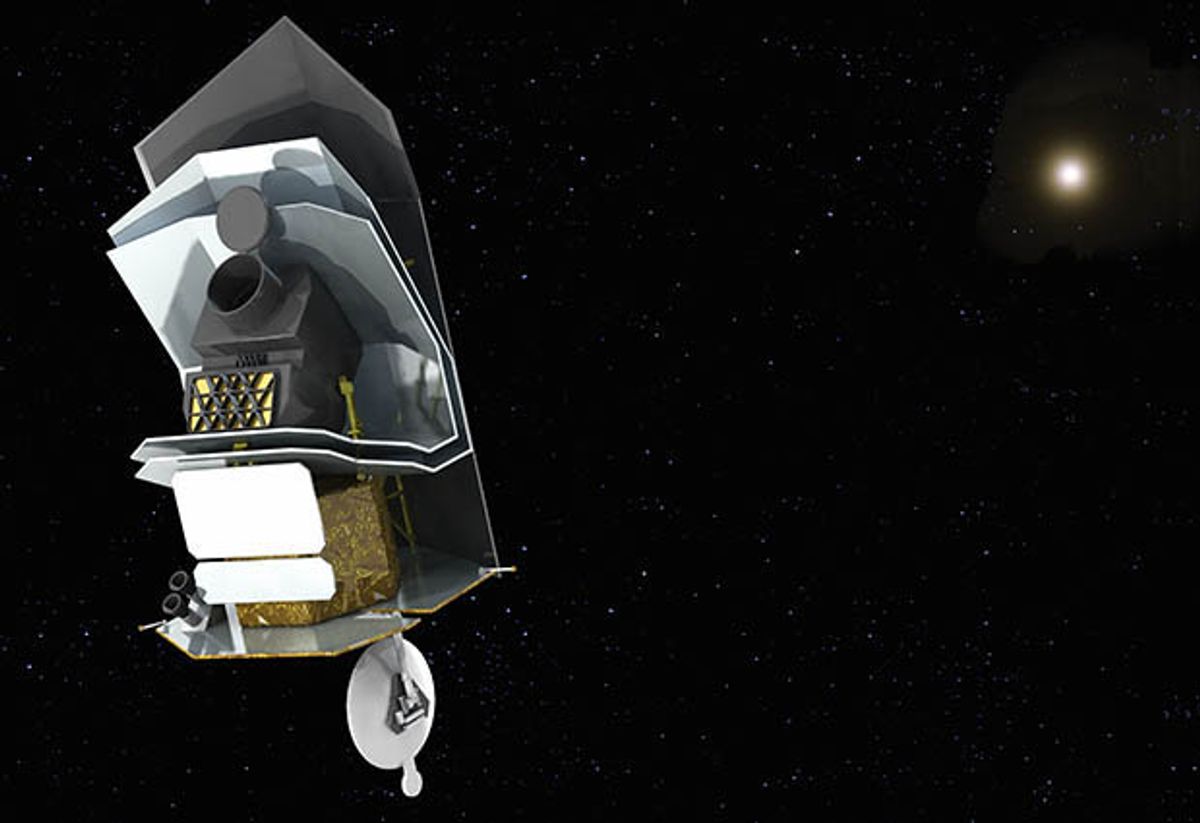
Humankind lives in a cosmic shooting gallery. For evidence of that, we need look no further than the events of 15 February 2013. On that day, a medium-size asteroid was set to pass some 28,000 kilometers from Earth, unusually close and well within the orbits of geosynchronous satellites. Dubbed 2012 DA14, the rock was first spotted the previous year. Since then, astronomers had been eagerly anticipating the opportunity to take a closer look and measure such vitals as size, shape, and composition.
But just as they were readying their telescopes, another asteroid took them completely by surprise. In the early morning hours of the 15th, a previously unknown piece of space flotsam entered Earth’s atmosphere and streaked across the sky, breaking up over the Russian city of Chelyabinsk. Briefly exceeding the sun in brightness, the rock exploded with the equivalent of 500 kilotons of TNT. The shock waves damaged roofs and walls, blew out thousands of windows, and injured more than 1,500 people, primarily from shattered glass.
Why didn’t we see this one coming? By scrutinizing the footage collected by dashboard cameras and building-security systems, scientists were eventually able to reconstruct details of the asteroid’s entry and demise. The object came from the sunward side of Earth, meaning it was never visible in the nighttime sky as it made its final approach. And analysis of the blast energy revealed that the cosmic interloper was a modest 19 meters or so in diameter, which would have made it difficult to see even if it had been visible after dark.
We’re fortunate that the asteroid was a small one. If it had been the size of 2012 DA14—some 30 meters—it’s likely that astronomers would still have missed it, and the damage could have been much worse.
The good news is that such events need not take us by surprise. Our team of former astronauts and scientists at the B612 Foundation, a nonprofit planetary-defense group, as well as engineers at Ball Aerospace & Technologies Corp., have devised a space mission, called Sentinel, that could go a long way toward finding asteroids on collision courses before they pose a danger to Earth.
Sentinel is the first space telescope dedicated to asteroid hunting. During six and a half years of operation, it will be able to spot more than 500,000 objects orbiting in the vicinity of Earth, dozens of times more than have been found to date. Not only could this rapid rate of detection reveal serious threats to the planet, it could also give people enough advance notice to do something about it.
Asteroids are small rocky objects—leftover rubble from the formation of the planets—that for the most part orbit the sun in a zone between Mars and Jupiter called the main asteroid belt. Millions of asteroids reside in this belt and have done so since the solar system formed more than 4 billion years ago. But not all have stayed there. Thanks to gravitational encounters with Jupiter, other planets, and one another, a subset of asteroids have had their orbits disturbed and now swing through the inner solar system, where they can pass close to—or even collide with—Earth.
These wayward asteroids are often called near-Earth objects (NEOs), a term that includes the occasional near-Earth comet. In the past few decades, astronomers have spotted more than 12,000 of them. But based on the low rate of rediscovery (how infrequently we see the same objects over and over again), we know there are many more out there. If there were no NEOs left to find, we would see only ones we’d already found; instead, our surveys keep turning up new ones.
Relatively small objects dominate the NEO population. The numbers are a bit uncertain given the incompleteness of our current observations, but it’s reasonable to expect that there are millions bigger than about 20 meters, more or less the length of a train car. Fewer than 1,000 are larger than 1 km.
Even a smaller NEO could create devastating loss of life and property if it were to strike a populated area. A 30-meter-wide asteroid hurtling through space can carry the kinetic equivalent of megatons of TNT, on the order of a hundred or more times the energy contained in the bomb dropped on Hiroshima. How that energy is released will depend on a variety of factors, including asteroid composition and angle of impact.
Impacts are more than a theoretical concern: There’s ample evidence that Earth has been hit multiple times before and could be again. In the 1960s, astronomer and geologist Eugene Shoemaker raised awareness of the possibility after he showed that the 50,000-year-old Meteor Crater in Arizona was formed by an impact with an asteroid. It’s now well established that the heavily eroded Chicxulub crater, in Mexico, was forged some 65 million years ago, when a 10-km-wide asteroid or comet slammed into Earth. The collision darkened the atmosphere and has long been thought to have led to the demise of the dinosaurs.
And it’s not all ancient history. In 1908, a roughly 40-meter-wide object burst apart over Tunguska in Siberia, Russia, flattening thousands of square kilometers of forest—some 80 million trees. Recently, data collected by a global network of infrasound detectors used to monitor nuclear tests has revealed airbursts created by the dozens of small asteroids that enter the atmosphere each year.
Based on the geologic record and what we know about the NEO population, the probability of a catastrophic event is quite low. A Tunguska-scale event might occur once every few centuries. Impactors as large as the 10-km-diameter object that finished off the dinosaurs very rarely collide with Earth, just once every 100 million years or so.
But of course, these are just average rates. The next asteroid with the potential to level a city might not hit Earth for hundreds of years; it could also arrive tomorrow. The only thing we can say with certainty is that there will be more collisions in our future.
Given enough advance warning, though, we should be able to protect ourselves. For a long time, the most dramatic and effective option seemed to be a nuclear bomb: Explode one near an asteroid and you could generate enough pressure to force the asteroid off course without breaking it into many Earth-threatening pieces.
But in 2002, astronauts Ed Lu and Rusty Schweickart, planetary scientist Clark Chapman, and astrophysicist Piet Hut joined forces to explore other ways to deflect or destroy a threatening asteroid—should one be discovered. By 2010, the B612 Foundation (named for the asteroidal home of the title character in Antoine de Saint-Exupéry’s The Little Prince) and the rest of the space community had settled on a few ways that humankind could feasibly deflect all but the largest asteroids.
One option, devised by Lu and fellow astronaut Stan Love, is called the gravity tractor. It would take advantage of the small gravitational attraction between a hovering spacecraft and the threatening asteroid. Given enough time, the tug of the spacecraft could nudge the asteroid’s orbit so that it would pass slightly ahead of or behind Earth. Another possibility is to send a robotic spacecraft on a high-velocity collision course, one that would transfer the craft’s considerable momentum to the asteroid. These methods are attractive alternatives to the prospect of sending nuclear weapons into space. There’s only one hitch: Because of the small changes in velocity these deflection approaches produce, any such mission would have to be launched years or even decades before the calculated date of impact.
Regardless of method, we can’t deflect an asteroid if we don’t know it’s coming. Finding potential threats has been the prime focus of planetary defense research for the last 20 years or so, and it continues to be the area that requires the most effort.
The organized asteroid hunt began with the very biggest objects in 1998, when the U.S. Congress directed NASA to initiate the Spaceguard Survey, with the aim of finding 90 percent of NEOs larger than 1 km within 10 years. To reveal these objects, NASA mounted a ground-based campaign of telescopic observation from multiple sites. By 2011, the agency met its goal, finding more than 900 of the estimated 1,000 or so NEOs larger than 1 km. Happily, none of them seem poised to strike Earth anytime soon.
The remaining NEOs of this size are on long, elliptical orbits that will only occasionally pass by Earth and so may take decades longer to find. Extending the search to smaller objects that could also be quite dangerous was the next logical step. Even before the Spaceguard Survey was complete, Congress did just that, calling for NASA to find 90 percent of NEOs that are at least 140 meters in diameter by 2020.
This goal is much more ambitious. NEOs aren’t easy to observe. As a general rule, they’re as dark as charcoal, absorbing most of the visible light that hits them. And the smaller they are, the less sunlight they reflect. Most can be detected only when they’re very close and so can be tracked for just a few days as they zip past Earth. This in turn limits how precisely their orbits can be pinned down. Many objects that are known today fly away from Earth in orbits so poorly charted that the timing and location of their next return can’t be accurately predicted. Indeed, the orbital parameters of nearly two-thirds of known NEOs are so uncertain that it will be difficult for astronomers to find them again when they return to Earth’s vicinity.

On Earth, astronomers have initiated several programs that will make big contributions to NEO discovery. The most ambitious employ telescopes with large fields of view and massive cameras. One facility, called Pan-STARRS (for Panoramic Survey Telescope & Rapid Response System), has for years been operating one of four planned telescopes on the island of Maui in Hawaii, with a 1.4-gigapixel camera, one of the world’s largest. And astronomers are currently moving forward with the Large Synoptic Survey Telescope (LSST), one of a new class of very large optical telescopes. LSST will start searching the heavens in 2022 from a mountain summit in northern Chile with an 8.4-meter-wide primary mirror and a 3.2-gigapixel camera.
These are powerful and sensitive tools. But they have their limitations. Because ground-based optical telescopes must operate at night, they’re blind to objects that approach from regions of the sky near the sun. They’re also limited by the need for good viewing conditions—a moonless and fairly turbulence-free sky, which might be on offer only a quarter of the time. But the most serious obstacle is water vapor in the atmosphere, which absorbs infrared light before it can reach the ground.
The infrared part of the spectrum happens to be where NEOs are easiest to see. Asteroids may be dark, but they’re warmed by sunlight and absorb and re-emit that light at infrared wavelengths. Ground-based observatories are blind to the part of the spectrum where NEOs are at their brightest, which limits their sensitivity.
Today, astronomers find about 1,500 or so new NEOs a year. LSST should be able to boost that discovery rate significantly—perhaps by as much as a factor of 10. But even with new telescopes in the works, it could be 20 years or more from now before ground-based efforts locate the 140-meter-or-larger objects NASA has been charged to find by the end of this decade. And it will take even longer to home in on smaller ones.
Eventually, these observatories could turn up an asteroid on a collision course with Earth. But we don’t know when the next one will hit. If we want to give ourselves as much time as possible to defend the planet, we’ll want to find any such hazards early. And the fastest way to find them is to go to space.
That’s easier said than done. Tight budgets have made prospects slim for government-sponsored science spacecraft. Although there is a proposal for a NASA mission called NEOCam, which would look for near-Earth asteroids, it hasn’t been picked up since scientists initially proposed it in 2006, and it’s competing with dozens of other possible space missions for funding.
Given these constraints, the B612 Foundation decided to move forward on its own with an infrared telescope called Sentinel, which would be the first space telescope dedicated to hunting for NEOs. The mission concept got its start in 2006 at Ball Aerospace, in Boulder, Colo., where I worked until retiring in 2008. Ball built NASA’s planet-finding Kepler Space Telescope as well as critical parts of NASA’s Spitzer Space Telescope, an infrared observatory. My group at Ball based its scheme for an asteroid hunter in part on the technologies it developed for those two spacecraft. In 2011, B612 issued a request for proposals and selected Ball to build, launch, and operate the observatory. I joined B612 that same year.
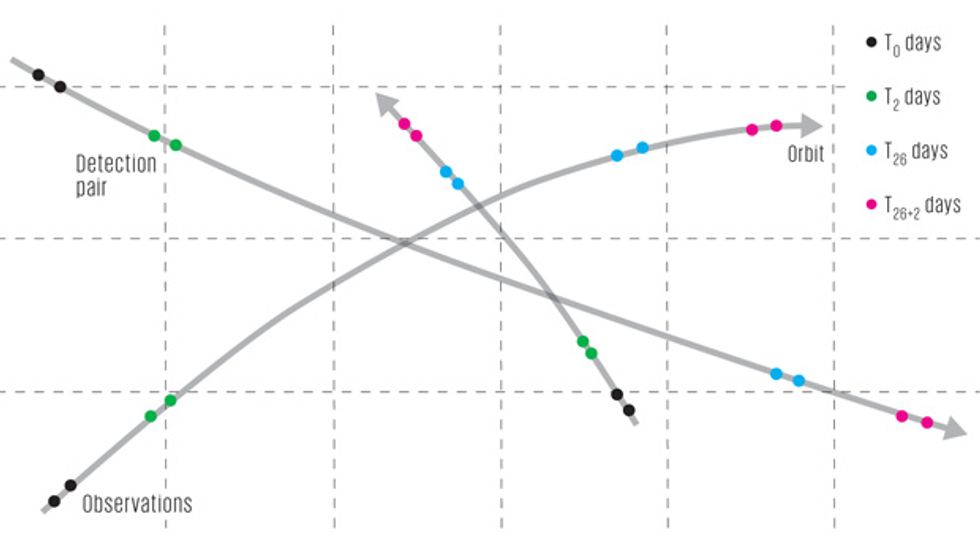
We expect the mission will cost US $450 million in all, a figure that will cover development, launch, and 6.5 years of operation. B612 is funding Sentinel through philanthropic donations, much as astronomical observatories were funded in the early 20th century. So far, we have raised enough money to build our team, fabricate engineering versions of the infrared detectors, construct a performance model for Sentinel to help plan our observing strategies, and establish our management plans. This is the first time anyone has attempted to fund a scientific, deep-space mission this way, but it’s quite possible it won’t be the last.
We plan to place sentinel in an orbit around the sun about 50 million km inside Earth’s orbit and not far from the orbit of Venus. There, the telescope will effectively sit with its back to the sun, continually scanning for objects with its 0.5-meter aperture and 30-megapixel infrared camera. This placement will allow Sentinel to see NEOs when they are close to the sun, during a time when they’re at their hottest and therefore radiating strongly at infrared wavelengths.
Sentinel’s proximity to the sun will let it generate twice as much power from its solar panels as it would in Earth orbit, but it will make thermal control more complicated. The spacecraft’s electronics must be held near room temperature, but the telescope must be kept below –208 °C, some 65 degrees above absolute zero, so that it won’t radiate heat at wavelengths that its camera would detect.
To keep things that cold, Sentinel will use a combination of techniques. The bulk of the cooling will come from a three-tiered cascade of sunshades. The first of these shades is the spacecraft’s array of solar panels. Because the solar array itself will heat up to more than 100 °C, two highly reflective thermal shields will be inserted between the solar array and the telescope to intercept the heat radiated toward the spacecraft and deflect it to space. The Spitzer telescope uses this same approach.
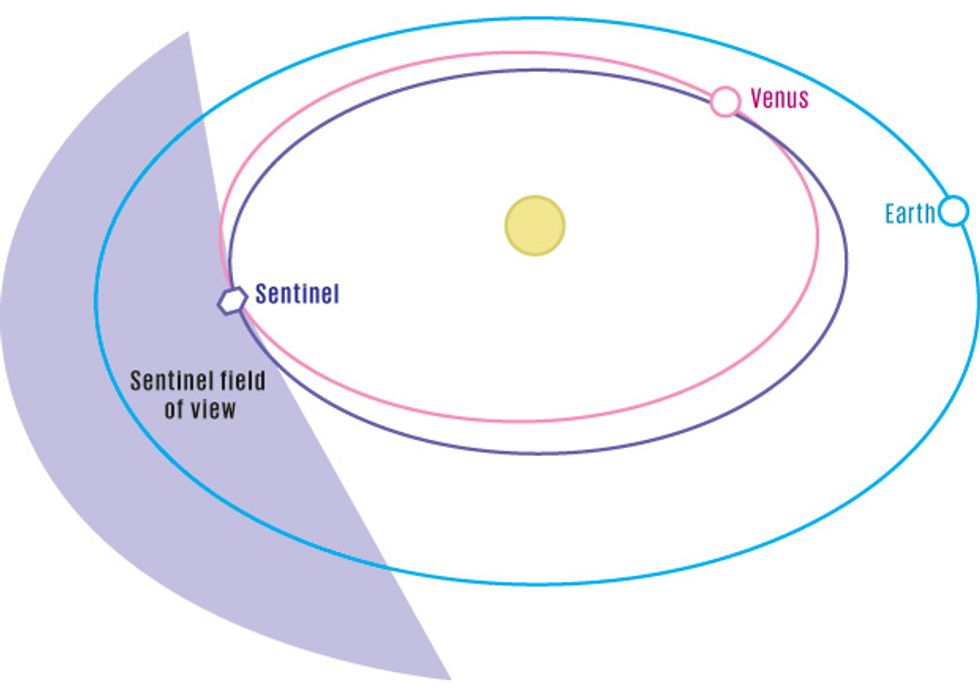
This arrangement will get the telescope temperature down to what is needed. But the detectors have to be even cooler, just 40 degrees above absolute zero, to keep thermal noise to a minimum. For that, we plan to use a mechanical cryocooler, a smaller and less massive alternative to the tank of cryogen, such as liquid helium and solid hydrogen, used on previous infrared space telescopes.
A somewhat unusual aspect of Sentinel is its mirror design. Reflecting telescopes typically have two mirrors: a primary that reflects incoming light onto a secondary that hovers above it, which then focuses the light onto a detector or objective. This tried-and-true design turns out to be a tricky one for infrared telescopes. Light can bounce off the support structure holding up the secondary mirror, and the structure itself can radiate heat that can be picked up by the detectors. To circumvent these issues, Sentinel will use three mirrors instead of two, in an off-axis configuration that will eliminate the possibility of any telescope structure getting between the detector and its view of the sky.
All told, Sentinel will have an 11-square-degree field of view, more than 50 times the area the moon takes up in the sky when viewed from Earth. Sentinel’s camera will take in this large field of view with a mosaic of 16 individual 1.8-megapixel CMOS detector chips. B612 has already gotten a start on these detectors, which are sensitive to wavelengths of infrared radiation from 5 to 10.2 micrometers, the range where NEOs emit most of their light. Raytheon Vision Systems, which is building the detectors, finished a prototype in 2013. The company is now building a full-scale engineering unit, a carbon copy of what will eventually fly on the telescope.
To hunt for NEOs, the Sentinel observatory will use its camera to look for objects that have moved relative to the background of stars between pairs of images. Sentinel’s hunting strategy could be categorized as “step and stare,” moving from one patch of the sky to another 15 times an hour, collecting light for 3 minutes at each spot. This same observing sequence will be precisely repeated in the next hour. Then the telescope’s computer will compare each pair of images of the same patch of sky.
An NEO won’t look much different than a star on a given snapshot, but it will move many pixels in that 1-hour interval. When two images taken 1 hour apart indicate a change, the onboard computer will store the 5-by-5-pixel area surrounding the change in both images. The observatory will then move to a new set of 15 areas of the sky for the next 2 hours, and then on to another set after that.
We expect there to be numerous spurious detections due to variable stars, main belt asteroids, charge deposited by cosmic rays, and other noise sources. But the protocol we’ve devised for content-driven data compression—saving only those areas of an image that show a change—should allow us to cast the net wide and still be able to send data back to Earth on anything that could potentially be an NEO. A typical space telescope might compress data by a factor of two or three. We’ll save only 1/1,000 of the data we collect. This reduction in data will help compensate for the paltry transmission rates you get with an antenna so far from Earth. It will also minimize how much time we’ll need to listen on the ground. NASA has agreed to let the B612 Foundation use the agency’s Deep Space Network, a global group of giant parabolic-dish antennas that are used to pick up spacecraft transmissions from all over the solar system. Time is a precious commodity on the network. With our image-processing strategy, we can store data for a week and then download it all (about 4 gigabytes) in a relatively economical 4 hours.
Astronomers at the University of Colorado Boulder’s Laboratory for Atmospheric and Space Physics will be the first to comb through the data. They will examine the pairs of images taken an hour apart to hunt for moving objects. Then they’ll compare these detections with ones taken two days later to see if any might correspond to physically possible orbits. Those detections that pass this test will be passed on to the Minor Planet Center of the Smithsonian Astrophysical Observatory, in Cambridge, Mass., which manages a huge database of all NEO observations. There astronomers will calculate an orbit for each object and send their results to the NEO Program Office at NASA’s Jet Propulsion Laboratory, in Pasadena, Calif., which projects orbits forward in time to look for stuff that could hit Earth. If NASA finds something, its office will issue a notice, and professional and amateur astronomers will be able to follow up with ground-based observations to improve our knowledge of the object’s orbit and get a better fix on the threat. Sentinel will also be able to pause its planned survey to take a closer look at objects of interest.
Sentinel is still in the very early stages. This year, we’ll finalize the engineering requirements for the Sentinel spacecraft and sign a firm fixed-price contract—one where all the costs are agreed upon up front—with Ball for spacecraft construction and operation. If our fund-raising efforts keep moving forward as they have, we will launch the spacecraft in 2019.
Once the mission begins, we should see a flood of new NEO detections. Based on Sentinel’s position and sensitivity, we expect it to turn up 200,000 NEOs smaller than 30 meters, 200,000 between 30 and 50 meters, and some 100,000 that are 50 meters or larger. In less than seven years, the telescope will be able to meet NASA’s goal of finding 90 percent of objects 140 meters or larger.
Of course, Sentinel’s survey will be nowhere near complete. For the hundreds of thousands of NEOs larger than 30 meters Sentinel will find, there are many more that it won’t. But any one of the NEOs that Sentinel does detect could easily be on a collision course with Earth. We calculate that there is about a 30 percent chance that Sentinel will find an impactor that will hit Earth sometime this century. And there will be others that will require detailed follow-up observations to know with certainty that they will miss us.
If Sentinel finds an object that looks likely to hit Earth, there are still many open questions about what we might do about it. Pushing or pulling on the object might divert it from a collision course, but even the most powerful form of deflection—a nuclear explosion—will require years of advance notice to engineer. Complicating matters is the fact that long-term predictions are difficult.
NEOs move around as they are pushed by the sun’s radiation and as they spin and reemit that radiation into space. These effects are hard to model precisely; the farther out in time we project an object’s orbit, the more uncertain that projection becomes. We won’t want to do anything to an asteroid’s path until we can be quite certain that we won’t risk making the situation worse. It may be that the best response is to monitor the object carefully and evacuate the area it will hit.
That said, the debate over these various courses of action will only be a theoretical exercise until we’re faced with a real threat. And the only way to know whether there is a threat is to go out and find it—before it finds us.
This article originally appeared in print as “A Sentinel for Space.”
About the Author
Harold Reitsema is the mission director of Sentinel. For many years, he led spacecraft design teams at Ball Aerospace. When he retired from Ball in 2008, he says, “I thought I had worked my last space science mission.” But a chance to build Sentinel was an opportunity too good to pass up.
